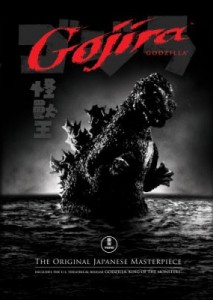 by Dave Umbricht and Nathan Cone
by Dave Umbricht and Nathan Cone
Dave
Gojira, Gojira, Gojira, Gojira, Gojira
Want to start?
Nathan
STOMP! STOMP! STOMP!
Of course I selected Gojira because our last review was all about a giant lizard attacking a major metropolis.
Like many kids, I grew up with the Godzilla movie series, including such memorable (ahem) films as Mothra vs. Godzilla, Son of Godzilla, and Godzilla vs. Mechagodzilla. And like most Americans, I knew nothing of the original Japanese version of the story, Gojira (1954).
When Rialto announced a restoration and re-release of the film, I scheduled it as part of the Texas Public Radio Cinema Tuesdays series, where it sold out a screening that was up against a Spurs playoff game. By all accounts, the crowd loved it.
I enjoyed Gojira, too, viewing it through the lens of history, as a film that came in Japan shortly after WWII, and is fraught with references to the atom bomb. But now, in the wake of Japan’s recent earthquake and nuclear disaster, Gojira looks scary again, with its shots of devastated cities and hospitals full of injured people.
Okay, so this is not a masterpiece — it’s still full of confounding dialogue, and the monster is still a guy in a rubber suit (the filmmakers had neither the time nor budget for stop-motion animation), but I think Gojira is a classic. The Japanese-language version, with its restored footage and the absence of Raymond Burr, has a sense of gravitas (even
with a rubber monster) that is lacking in the American version.
Dave
Growing up, channel 56 out of Boston had the creature double feature on Saturday afternoons.
The movies spanned from B movies from the 50’s (Incredible Shrinking man stuff) to Hammer films of the 60’s (I loathed the days when these period pieces cluttered the airwaves, to this day I’m not a huge Hammer fan). My favorites were Godzilla and his friends. There was nothing like watching two giant monsters beating the hell out of each other while destroying the Tokyo infrastructure.
The only problem with these movies? The times when Godzilla was offscreen and the humans (or aliens, there always seemed to be aliens) would speak. I tuned out, and probably changed the channel or started playing Intellivision during some of those scenes.
Here’s the irony, when watching Gojira, I loved the scenes with the humans (no discernible aliens here) and loathed every scene with Godzilla. Maybe it isn’t as surprising as I make it out to be. Really, Godzilla doesn’t do a lot in the film, other than one extended sequence. But there is something fascinating about this film made less than ten years after the end of World War II. There is so much pain and baggage from the aftermath of the war and the atomic destruction of Hiroshima and Nagasaki.
There are a number of chilling scenes that mimic the destruction from the war: seeing Tokyo laid in ruinous flames; a mother huddled with her children as Godzilla approaches, embers raining around them, she tells the children that they will all soon be with their father again (who we know must have died during the war); and most affecting, a nearly silent scene in a hospital where doctors scan a child for radiation. These evoked some of the same emotions I felt when watching one of my favorite films, the devastating Japanese anime, Grave of the Fireflies.
There are other deep themes at work here. Most notably, the burden of science and power. I was fascinated by the parallels between atomic energy and the “power” that the “mad” scientist (mad because he wears an eye patch) discovers. He claimed he would never let anyone know about his energy, until he could develop a useful (and peaceful) purpose for it.
This didn’t feel like a political damning of the United States and what it had done, rather it was the statement of a country still dealing with the repercussions of nuclear devastation. And perhaps dealing with guilt as well, as the scientist bristled when told by a reporter that a German scientist had informed him of the scientist’s discoveries, “I have no German colleagues.”
Wait a second, this is a movie about a giant lizard breaking stuff, isn’t it?
Nathan
When I saw Gojira in the theater a few years ago, I actually cried when the mother tells her children they’ll “be with daddy soon.” That is such a heartbreaking scene – it’s all of ten or fifteen seconds, I think. It actually makes the monster seem more real.
I had forgotten all about the German reference. Very interesting. I think your take on the Japanese scientist’s motives is a good one.
But you can’t separate Godzilla from the movie itself, so rubber lizard and all, did you like it?
Dave
I liked it, but it wasn’t Godzilla to me. Part of that is nostalgia, part of that is Godzilla’s character. Because in future movies he has a personality, he is our protector. He’s like that rogue cop that does millions of dollars worth of damage to the city while saving the day. In this film, he’s like any other monster. He was just a force of nature causing fear and destruction. There is no surprise that Roland Emmerich, the king of destruction, took a crack at this Godzilla story.
Bottom line, I liked it, not for Godzilla, but for the small moments of reaction that the human characters had to the threat. And as you said in your first comment, it is interesting from a historical perspective, seeing the wounds of a country vulnerably exposed in the midst of a silly monster movie.
Nathan
And with that, would you like to suggest the next title?
Dave
Rashomon?
Nathan
Great movie! I’ve seen it three times. If you’re going for a Kurosawa pick, here’s what I’ve already seen:
The Hidden Fortress
Yojimbo
Sanjuro
Rashomon
The Seven Samurai
Dersu Uzala
Dreams
Ran
Dave
Tokyo Story?
Nathan
That’s a winner! It’ll be interesting to see it and Late Spring in quick succession. Our TPR film series is screening Late Spring next Tuesday (http://www.tpr.org/cinema/index.html). I’ve never seen any Ozu.
So, join Nathan and Dave as they indulge themselves in the quiet simplicity of the Rock God known as Ozu.


